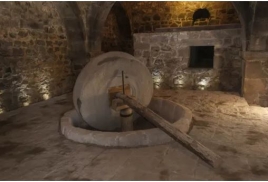Armenian Oldest Winery
Thursday, November 9, 2023
Areni-1 is a location located in the Caucasus Mountains in present-day Armenia. This historic winery—the oldest in Armenia—has yielded a complete set of vintner’s tools, such as a fundamental grape press, baskets, a clay-based fermenting vat with a 14-15 gallons capacity, drinking vessels, and skins, organic grapevines, and seeds.
Though the common evidence suggests that the cave has been in service for many hundred years, the radiocarbon dating process has specified that the Areni-1 winery could be operational during the period, 4100 to 4000 BC – during the Chalcolithic Period, or Copper Age. It was the period during which man had first attempted jotting down pictograms, making wheels, and planting seeds.
In the 8th century BC, Armenia was referred to as “the Land of the Vineyards” by Urartu’s kings. Armenians had business relations to Babylon and would sell such wines, according to Herodotus’ writings. Armenia was the birthplace of winemaking, which later expanded to Georgia, Persia, Mesopotamia, Egypt, Greece, and Rome over the years. Herodotus also stated that while Assyria produced wine during that time, Babylon received wine from Armenia. Hence, it vividly implies that Armenian wine was far superior in quality & taste.
Patrick McGovern—scientific director of the Biomolecular Archaeology Project for gastronomy—fermented beverages, and discovered signs of wine on an 8,000year-old Stone Age fragment of pottery found on a modern-day Georgian site.
Ron Pinhasi and Boris Gasparyan of the Institute of Archaeology & Ethnography of the National Academy of Sciences of Armenia carried out the excavations for the Areni Project in the first ten years of the twenty-first century, which were funded by the Gfoeller Foundation (USA) and University College Cork (Ireland). In 2008, Gregory Areshian, who was then the co-director of the Areni Project, invited the University of California, Los Angeles (UCLA) to collaborate on this project.
Since that time, UCLA and the National Geographic Society have provided funding for the excavations. The winery excavations were finally finished in 2010. Ancient winemaking equipment was discovered there in 2007 when Areshian and Armenian archaeologist Boris Gasparyan co-directed excavations at the Areni-1 cave complex.
In September 2010, archaeologists completed uncovering a sizable, two-foot-deep (or 60 centimetres) vat that had been buried close to a small, one-meter-long (or 3.5-foot) clay basin with rising borders. A recently-discovered web of “new passages, galleries, and caverns,” along with 26 graves and counting, revealed that the site could be much larger, and its objective could be much creepier.
“The cave’s use of wine was just not designed for general feasting or daily consumption, ” Areshian hypothesized. He further stated, “In this instance, we may infer that wine was consumed as part of customary ceremonies including the procedures of remembering the deceased as well as countless cults and rites for the underworld”.
After the collapse of the Soviet Union, on September 21, 1991, Armenia regained its freedom. After the independence, many young Armenians and those with money started to embrace the region’s ancient techniques and wine culture. Armenia thus holds the distinction of having both the oldest and youngest wine industries in the world.
If the “winery” at Areni-1 cave operated as Areshian has hypothesized, not much has changed in viniculture during these 6,000 years. He describes it by stating, “We can infer that grapes were harvested, collected in those baskets, and transported to that pressing installation, where they were pressed manually with hands or bare feet, or the juice trickled along the basin’s slanted surface into the vat, in which it fermented.” Hence, the modern winemaking process almost resembles the ancient times of Areni-1.
The presence of the traces of malvidin (a chemical compound) in a clay pot led biochemists to believe that the Areni vintners had been producing red wine. “The residue was naturally sinking, although the wine [inside the canister] managed to remain on top,” Areshian explained. “Not unlike today’s unfiltered wines.” McGovern hypothesized this, but besides being traditionally enclosed in jars, the wine might have been utilized in a novel manner by the cave’s inhabitants. He said, “You have everything right at hand to serve wine to your ancestors, your deceased. You have the appropriate temperature within the cave to keep the wine cold during the vinification process.”
The next earliest instance of a real wine press after Areni-1 is two and a half millennia younger: Two plaster basins that appear to have been used for grape pressing between 1650 and 1550 BC were found in Israel’s West Bank in 1963.





